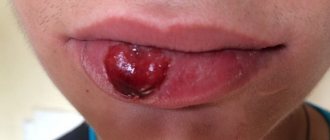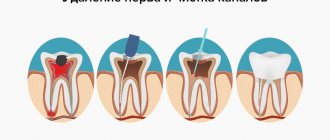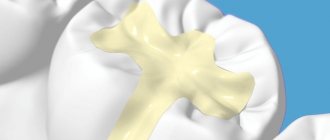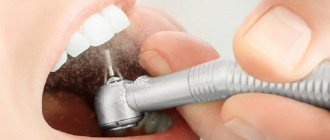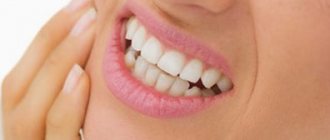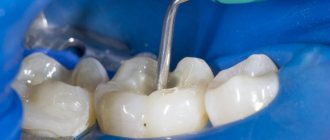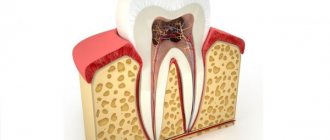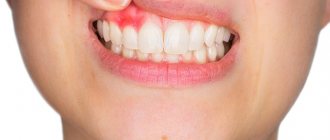Why does a tooth that has already been treated hurt?
The dentist who filled the tooth and placed a filling may encounter patient complaints of pain. After removal of infected and necrotic tissues, the appearance of toothache is a normal reaction of the body to the operation.
Attention! The occurrence of lingering pain in treated teeth can have several causes , which depend on the original problem and the method of its treatment.
Here are some reasons why a treated tooth may hurt:
- chronic pulpitis and other forms of periodontitis with deep caries , since incorrect actions by the doctor will cause future toothache.
- In case of pulpitis and similar diseases, it is necessary to first cure the dental canals and only then apply a filling to the tooth.
- Incorrect treatment of caries with budget equipment without air-water cooling of the treated area leads to overheating of hard dental tissues. This can provoke burns and necrosis of the pulp, which lead to chronic pulpitis and toothache as such.
- Treatment of caries under anesthesia does not allow the doctor to accurately determine the height of the filling for a correct bite; the patient is not able to help the doctor polish the filling perfectly, since the lower jaw is immobilized. Thus, after treatment, a person is bothered by pain when biting, a feeling that the filling is too large and he wants to reduce it according to the bite.
Important! There is an opinion that a filling that interferes with the bite will itself wear off over time so that the person becomes comfortable. But this is a misconception, this method is dangerous to health, because an over-inflated filling is a source of constant pain, cracks and crevices, traumatic periodontitis and tooth loss.
- The filling itself and its constituent materials can cause pain after treatment. As the composite filling hardens, it may decrease in volume, and the walls of the tooth will begin to experience stress and crack.
Why the whole body hurts: main reasons
As you know, most often pain throughout the body is the body’s response to various infectious diseases (can even be a consequence of pneumonia!), all kinds of injuries and physical stress.
Infectious diseases are often accompanied by the following symptoms: the whole body hurts, aching bones and joints, restless sleep, headache, fever. It also happens that in the presence of an infectious process, the temperature, on the contrary, decreases, and the patient experiences malaise in the form of lethargy, reluctance to move and the release of cold sweat. At the same time, pain throughout the body is often observed with such problems as:
- Various blood diseases (lymphoma, leukemia, etc.);
- The presence of a malignant tumor;
- Autoimmune diseases (eg, lupus);
- Connective tissue damage (rheumatoid arthritis);
- Food poisoning;
- Tick bite.
Blood diseases and malignant tumors require immediate treatment, so if the body hurts constantly, but there are no cold symptoms, it is necessary to undergo examination as soon as possible.
In autoimmune diseases and connective tissue damage, the pathogenic process inside the joints contributes to the spread of pain to the adjacent muscles. This explains the pain throughout the body, which prevents a person from living a full life.
Characteristic signs of rheumatoid arthritis are pain in the morning after sleep. As a rule, after the patient moves a little, they subside significantly. With osteoarthritis, the body hurts, on the contrary, in the evening.
Food poisoning can also be the answer to the question of why all the muscles of the body hurt. Very often, such ailments are accompanied by additional symptoms such as high fever, general weakness of the body, sharp pain in the lower abdomen. Again, there are cases when the temperature is below normal, the patient experiences chills, cold sweat appears on the body and the whole body hurts.
The bites of some ticks, which are carriers of an infectious disease, can also cause aching pain throughout the body. Determining the cause of the disease in this case is not particularly difficult: as a rule, after such a bite a rash appears in the form of small blisters with a clear liquid inside. In addition, redness of the skin is often observed not only at the site of the bite, but also in other parts of the body.
Thus, if the body hurts constantly, you should immediately consult a doctor. Indeed, in addition to the fact that this symptom may indicate the presence of various diseases, it can often lead to the following problems:
- Severe chronic pain that replaced moderate pain;
- Fatigue;
- Insomnia;
- Weakening of the human immune system;
- Forced cessation of activity;
- Stress and sudden mood swings;
- Other psychological problems (increased irritability, anxiety, unexplained fears, depression, etc.).
Why does a whole treated tooth hurt when you press or put pressure on it?
It is within normal limits if the pain in the treated tooth, which appears during meals, lasts no more than a week and gradually subsides until it disappears completely. This is due to the reaction of the gum and tooth tissues to the removal of the infected pulp, subsequent processing, expansion of the canals and the introduction of filling material into them.
With a cold and a weakened immune system, aching pain may appear while eating, but the reason lies not in the tooth, but in the inflamed gum adjacent to it.
Some people also experience discomfort when impacting a tooth that has been healed due to high surface sensitivity or hyperesthesia , due to eating too hot or cold foods, as well as microcracks caused by chewing hard foods.
You should be wary of prolonged severe pain when directly affecting a tooth, which indicates possible periodontitis - inflammation of the upper part of the tooth root, caries.
What to do if toothache persists after treatment
The first time after visiting the dentist, toothache can be treated at home using traditional methods, painkillers, dental drops, lotions or ointments. But pain that lasts more than a week , brings severe discomfort, and cannot be relieved by any self-help or home methods, should raise reasonable concerns . It is necessary to consult a dentist in time and not delay treatment, otherwise you may not only run into complications and develop oral diseases, but also lose a tooth.
Gargles for Pain Relief
If you encounter toothache after applying a filling, you can turn to traditional methods of getting rid of unpleasant sensations.
Warm rinses with a solution of soda and salt will help ease the body's reaction after the dentist's intervention. To do this, you need to put a teaspoon of soda and salt in a glass with warm or tolerably hot water and stir. Rinse 4-5 times a day.
The solution will become more effective if you add 2-3 drops of five percent iodine , but you must remember about contraindications and individual intolerance.
Decoctions of pharmaceutical herbs, namely chamomile, sage and oak bark , also effectively combat the unpleasant sensations that arise after visiting the dental chair.
Reference! Herbal rinses can stain tooth enamel.
Preparation add 2 tablespoons of herbs 200 ml glass and pour boiling water , leave for 20 minutes , then strain and rinse , focusing on the painful area.
Pharmacy and medications are considered a reliable alternative to the above methods of rinsing the mouth. Among the agents with an antiseptic effect, “chlorhexidine 0.05%” and “miramistin 0.02%” . Good anti-inflammatory drugs are Tantum Verde and Stomatofit , diluted before use in warm water in a ratio of 1:5 .
Hydroperit tablets , 3% hydrogen peroxide and 30% con should be used very carefully and carefully, as they have contraindications and side effects.
Attention! The listed agents are varieties of hydrogen peroxide and have an oxidizing effect, aggressively affecting the enamel, and the air bubbles in them increase the pressure in the pulp chamber.
Symptoms of pain that require immediate medical attention
You should immediately contact a specialist if you have the following symptoms :
- swelling of the gums around the tooth;
- chipped tooth or filling ;
- loss of filling;
- fistula on the gum;
- increased tooth sensitivity ( hyperesthesia );
- unbearable pain;
- mobility ;
- pain in the jaw .
What to do with stomach pain?
In most cases, antispasmodics and painkillers solve the problem of pain in the moment, but do not cure the disease. And painkillers and anti-inflammatory drugs even worsen diseases of the stomach, liver and intestines, while providing immediate relief.
You need to understand that pain from organs in the abdomen is associated with increased permeability of the mucous membrane and impaired epithelial protection. Pain in the stomach and esophagus occurs when hydrochloric acid hits receptors in the deep layers of the mucous membrane and wall of the organ. The distance between cells increases, and bile acids penetrate between the cells, irritating pain receptors. It’s the same in the intestines: with an increase in the distance between cells, that is, increased intestinal permeability, all irritating, harmful and toxic substances penetrate the intestinal wall, irritating the nerve endings. This causes us to experience pain.
In the moment, pain from organs can be removed by antispasmodics and painkillers. But the problem can only be cured by a course of treatment aimed at restoring the protective barrier of the epithelium and mucous membrane of the stomach, esophagus, and intestines. There is only one solution for this so far - rebagit based on remabipide, which restores the mucous membrane at all three levels and throughout the gastrointestinal tract. It stimulates the production of prostaglandins and reduces signs of inflammation. Due to this, contacts between cells become denser and the permeability of the mucosa is restored.
Pain after periodontitis treatment
This disease is characterized by the presence of a purulent inflammatory process occurring in the peri-root tissues of the tooth. The chronic stage of development of this pathology is often asymptomatic. Therefore, the patient may experience pain only after the start of treatment for periodontitis.
Treatment of this disease is a rather complex and lengthy process, consisting of several stages.
- Installing a temporary filling using certain medications that contain calcium hydroxide. Tooth canals are filled for a period of 1.5 to 2 months. This stage allows you to prevent re-infection and build up bone tissue located near the top of the tooth.
- Symptomatic therapy with anti-inflammatory drugs.
- Removal of temporary filling material and installation of permanent filling.
Norm
If all the above-described stages of periodontitis treatment were carried out in compliance with the requirements, it means that the pain that arose during and after the procedures was caused by the process of trauma to the tooth tissue and is temporary. In some cases, the pain can last up to 2 months and then disappear.
Periodontitis is characterized by the accumulation of pathogenic microorganisms in the bone tissue surrounding the tooth root. If before treatment bacteria were freely transported from the oral cavity to the roots of the tooth, then after filling the canals, access to the dental roots is closed for them. The canal filling procedure makes it possible to localize foci of infection, making it easier for the body to neutralize and neutralize microbes.
In the presence of a weakened immune system or an individual specific reaction to sealing of the dental canals, an inflammatory process may develop, accompanied by pain. Even if the tooth has not previously been bothered, after treatment of periodontitis it may react with dull throbbing pain to touching, tapping, or pressing on its surface.
Pathology
The most common causes of toothache after periodontitis treatment are:
- the presence in the sealed dental canals of a small fragment from any dental instrument. During the treatment process, the dentist may not have noticed the smallest part of the instrument that had broken off;
- the formation of additional holes during the perforation procedure;
- excessive or insufficient amount of filling material used to install the filling.
If the described medical errors occurred, the tooth will have to be re-treated. And if swelling of the dental and gingival tissues develops, it may be necessary to make an incision into the tissues in order to remove purulent accumulations and subsequent treatment with antiseptics. Sometimes it is necessary to prescribe antibacterial drugs.
You should consult a doctor immediately if:
- general health has worsened;
- body temperature increased;
- the tooth has become wobbly;
- there is a sharp acute pain;
- swelling of the soft tissues surrounding the causative tooth;
- when trying to close the jaws, severe pain occurs.
Pain after pulpitis treatment
Pulpitis is characterized by the presence of an acute inflammatory process occurring in the neurovascular bundle of the tooth. Treatment consists of removing the dental nerve followed by filling the apex of the tooth.
Pain after pulpitis treatment is normal. After all, part of the tooth pulp was removed, and some dental tissues were subject to serious injury. Pain can also be associated with irritation of nerve endings due to the effects of antiseptics used in the treatment of pulpitis.
Norm
Toothache, which is considered normal after nerve removal and dental canal filling, lasts an average of 1-3 days, after which it begins to gradually subside. Pain syndrome can occur when pressing on a pulpless tooth and/or when tapping on its surface. Such pain may be present for about 1-2 months, no more.
Pathology
Due to incompetent treatment of pulpitis, the following symptoms may occur:
- acute, persistent pain;
- a feeling of pulsation in the soft tissues that surround the diseased tooth;
- swelling of the gums and cheeks.
All these symptoms indicate the development of an acute inflammatory process. If they occur, it is recommended to consult your doctor, who will take an X-ray of the tooth and prescribe appropriate treatment. As a rule, therapy is limited to making an incision in the gingival tissue, removing purulent exudate and disinfecting the wound.
Among the complications of improper treatment of pulpitis are the development of:
The most serious consequence of improper nerve removal is tooth extraction.
You should seek dental care after removing a nerve from a tooth if:
- the occurrence of pronounced swelling of the cheek and gum tissue around the diseased tooth;
- the presence of severe weakness throughout the body;
- sudden increase in body temperature;
- if you feel acute pain when eating.
Pain after caries treatment
Pain syndrome after dental canal filling can be caused by:
- firstly, excessive trauma to dental tissues, which need some time to recover. Such cases occur when the carious lesions were deep and extensive;
- secondly, improper adherence by the dentist to dental canal filling technologies. For example, in case of under-dried or over-dried dental cavity before the procedure of filling the dental canals.
Norm
The occurrence of mild periodic aching pain after treatment of caries indicates that it is not pathological. Moreover, the pain syndrome in this case will gradually subside, and swelling of the cheek and gum tissue will not be observed.
Often pain occurs after deep caries has been removed. In this case, the bottom of the carious cavity is located close to the pulp. And due to the mechanical effect on the surface of the filling, this effect also affects the pulp tissue. Pain may occur when:
- pressure is applied to the filling, even if it is insignificant;
- solid food gets on the filled tooth (during chewing);
- Scrape along the surface of the filling with a toothpick or fingernail.
After 1-3 months, such pain weakens and then disappears completely. The fact is that the pulp produces a protective layer of dentin, which allows you to “fence off” the filling. Until this happens, the patient may feel pain due to mechanical and thermal effects on the filling.
A slight dull pain can also be a reaction to procedures performed during the treatment of caries:
- “exposure” of the filling material with halogen rays;
- treatment of carious cavities with antiseptic agents;
- processing of tooth tissue using a drill.
If pain of this nature is observed for no more than two weeks, it is not pathological.
Pathology
If the pain after treatment of caries occurs suddenly, mainly at night, is acute and pulsating, the development of acute pulpitis is most likely occurring.
If pain occurs during and after eating cold and hot food, as well as when pressing on the surface of the causative tooth, it can be assumed that chronic pulpitis has begun to develop.
Also, when a tooth reacts to temperature stimuli, if the filling is located in close proximity to the gum, it is necessary to evaluate whether one of the edges of the filling material is overhanging (a step or gap between the edge of the filling and the tooth).
If you detect uneven edges of the filling, you should consult a doctor. After all, such a defect will systematically injure the gums, which will lead to the development of inflammatory processes in its tissues. The next stage of this complication will be the exposure of the tooth root, which is not covered with enamel and therefore reacts sharply to various irritants.
A clear sign of developing pathology after caries treatment is the concentration of pain in the area of only the tooth that was filled.
You should contact your dentist after caries treatment if the following symptoms occur:
- the treated tooth reacts acutely with pain to the process of chewing food, as well as eating hot, cold, sweet and sour foods;
- toothache occurs without any impact on the tooth, mainly at night;
- the pain is paroxysmal;
- the pain syndrome does not stop even after a month after caries treatment;
- the pain is not relieved even by taking painkillers.
Signs of the disease
Almost all symptoms of low pressure are observed if there is a violation of blood circulation in the vessels of the brain. Some complain of throbbing pain in the temples, more often in the back of the head. Migraine-like pain that occurs only in one half of the head is also not uncommon. This is a constant dull pain that is accompanied by nausea and even vomiting.
When the weather changes and magnetic storms, your health deteriorates significantly. Darkening of the eyes will also be a sign of low blood pressure. In some cases, loss of consciousness cannot be excluded.
If nothing is done, the person becomes absent-minded and his memory deteriorates. The vital activity of the body decreases as a result of slowing blood flow. When you have a headache with low blood pressure, what to do is the only question that interests the patient. Hypotonic people often suffer from depression, they are emotionally unstable, easily irritated and suffer from constant mood swings.
Reiter
Let's immediately make a reservation that treated teeth may hurt immediately after treatment or after quite a long time. In both cases, “ the treated teeth hurt ” for completely understandable and objective reasons. The cause of pain can be understood by its characteristics and systematicity/constancy. It is a normal phenomenon (the dentist himself warns about this) when “cured teeth hurt” after endodontic treatment or treatment of deep caries - a conscious violation of muscular, neurotic and bone established connections manifests itself in the protective reaction of the human body.
Treatment of deep caries can provoke increased tooth sensitivity:
- - when biting - typical for teeth with installed fillings and cavities in the upper part (in the fissure area);
- - reactions to cold and hot are more noticeable with carious planes in the cervical part of the teeth. Similar symptoms may occur during the treatment of wedge-shaped defects.
100% painful sensations will appear when placing a refractive thread under the gum - in this case, the treated teeth hurt due to the exposure of the neck of the tooth (under normal conditions, this part is hidden by the gum).
Pain for all of the above reasons is predictable, natural and will subside over time, but if it occurs, it is best to contact your dentist for advice on pain medications and precautions.
Post-filling pain during endoscopic treatment
The appearance of such pain is associated with the installation of a diagnostic (temporary) filling when trying to keep the tooth alive without leading to depulpation. The installation of a “temporary rack” is necessary for examination and understanding of the infection of the pulp and its, so to speak, viability. If, after installing a diagnostic filling, the tooth begins to hurt (the doctor is obliged to warn the patient about this possibility), then its depulpation (pulling out) is inevitable.
After tooth extraction or complete root canal treatment (filling), pain can occur for two reasons:
- - incomplete removal of the pulp (occurs as a result of medical negligence and can be regarded as a medical error with all the ensuing consequences);
- - anatomical features of the structure of the tooth and its root (strictly individually with visualization on an x-ray).
Treated teeth hurt
after pulpitis is a very common occurrence. It is due to the fact that after filling it is mandatory to take a control photo, which will show all the dentist’s flaws. True, inexorable statistics show that all defects, if any, come out after the warranty period, so it will not be possible to influence the doctor in any way.
Pain after tooth extraction
Here everything is much simpler - the removal of teeth and nerves is accompanied by traumatic damage to soft tissues, blood vessels and root canals. This is an absolutely natural practice, the doctor warns about it. The only plus is that the pain is not pronounced; rather, the site of impact aches or pulsates.
In another vein, treated teeth hurt when root canals and adjacent soft tissues are treated with antiseptic solutions (by the way, extremely powerful drugs are used in dentistry). If the drug gets on the gums or just beyond the edges of the root canal, a strong irritation reaction may occur, which is accompanied by mild and short-term pain (usually disappears within the first few hours).
Medical errors
In this case, the treated teeth hurt much more often than all other causes. When filling root canals, it is not allowed to remove the filling material beyond their boundaries; in the same way, you cannot leave an unfilled niche - both situations lead to pain as a result of the proliferation of microorganisms and progressive caries or pulpitis.
If the work technology is violated, consumables (cotton wool) may get into the deep layers of the tooth, which will subsequently lead to its destruction. It is not uncommon for thin dental instruments to break off (especially during mechanical cleaning of root canals) - although this is considered to be the fault of the doctors, if it is impossible to remove the fragment, the tooth must be removed.
Causes of pain
1. Heart
If you have heart problems, you may experience pain in the chest area around your heart. However, you may also feel a reflex pain that shoots down your left arm or into your upper mid-back.
Experts explain that heart pain is often reflected in the area of the body where impulses are transmitted to the spinal cord, which receives sensations in the heart area. This is especially true for the left side.
Any pain related to the heart may indicate a serious problem and is a reason to visit a doctor.
2. Lungs and diaphragm
Problems with your lungs and diaphragm may cause you to feel pain on one side of your neck or shoulder area.
This pain is caused by breathing problems or the phrenic nerve, which runs from the spine to the lungs and diaphragm.
Many people who experience neck tension suffer the effects of poor breathing and other more serious diaphragm problems.
You should not ignore these symptoms, but it is better to consult a doctor.



